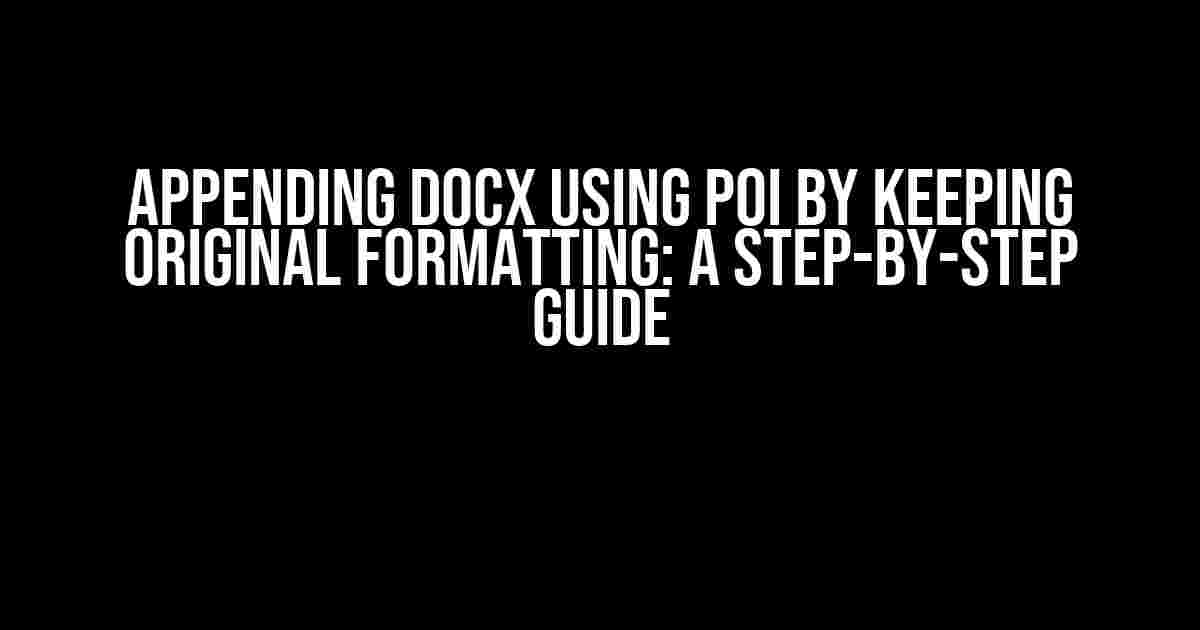Are you tired of losing the original formatting of your Word documents when appending them using Apache POI? Look no further! In this article, we’ll take you through a comprehensive guide on how to append docx files while maintaining their original formatting.
- What is Apache POI?
- Why is formatting important?
- The Challenge: Appending docx files while preserving formatting
- Step 1: Setting up the environment
- Step 2: Reading the source docx file
- Step 3: Creating a new XWPFDocument instance
- Step 4: Appending the source docx content
- Step 5: Preserving formatting
- Step 6: Writing the appended docx file
- Putting it all together
- Conclusion
- Best Practices
- FAQs
What is Apache POI?
Apache POI (Poor Obfuscation Implementation) is a popular open-source Java library used to read and write Microsoft Office file formats, including docx. POI provides a wide range of features, including file format manipulation, data extraction, and document creation.
Why is formatting important?
When working with Word documents, formatting is crucial. It enhances readability, makes the content more engaging, and conveys the intended message more effectively. Losing formatting during the appending process can lead to confusion, misinterpretation, and even damage to your brand’s reputation.
The Challenge: Appending docx files while preserving formatting
The main challenge when appending docx files using POI is preserving the original formatting. POI’s default behavior is to strip away the formatting, leaving you with a plain text document. However, with the right techniques and approaches, you can overcome this limitation and achieve seamless appending while maintaining the original formatting.
Step 1: Setting up the environment
To get started, you’ll need to have the following:
- Java 8 or later installed on your machine
- Apache POI 4.1.2 or later (we’ll be using version 4.1.2 in this example)
- Eclipse or your preferred IDE
- Two or more docx files to append
Create a new Java project in your IDE, and add the Apache POI library to your project’s classpath.
Step 2: Reading the source docx file
Using POI, read the source docx file into a XWPFDocument object:
import org.apache.poi.xwpf.usermodel.XWPFDocument;
public class DocxAppender {
public static void main(String[] args) throws Exception {
// Read the source docx file
XWPFDocument sourceDoc = new XWPFDocument(new FileInputStream("source_docx_file.docx"));
}
}
Step 3: Creating a new XWPFDocument instance
Create a new XWPFDocument instance to serve as the target document:
// Create a new XWPFDocument instance XWPFDocument targetDoc = new XWPFDocument();
Step 4: Appending the source docx content
To append the source docx content to the target document, you’ll need to iterate through the paragraphs, tables, and sections of the source document and add them to the target document:
// Iterate through the source document's paragraphs
for (XWPFParagraph para : sourceDoc.getParagraphs()) {
// Add the paragraph to the target document
targetDoc.addParagraph(para);
}
// Iterate through the source document's tables
for (XWPFTable table : sourceDoc.getTables()) {
// Add the table to the target document
targetDoc.addTable(table);
}
// Iterate through the source document's sections
for (XWPFSection section : sourceDoc.getSections()) {
// Add the section to the target document
targetDoc.addSection(section);
}
Step 5: Preserving formatting
To preserve the original formatting, you’ll need to clone the styles and formatting from the source document and apply them to the target document:
// Clone the source document's styles XWPFStyles styles = sourceDoc.createStyles(); targetDoc.importStyles(styles); // Clone the source document's numberings XWPFNumbering numbering = sourceDoc.createNumbering(); targetDoc.importNumbering(numbering); // Clone the source document's theme XWPFPictureData theme = sourceDoc.getDocument().getTheme(); targetDoc.getDocument().setTheme(theme);
Step 6: Writing the appended docx file
Finally, write the appended docx file to a new file:
// Write the appended docx file to a new file
FileOutputStream out = new FileOutputStream("appended_docx_file.docx");
targetDoc.write(out);
out.close();
Putting it all together
Here’s the complete code:
import org.apache.poi.xwpf.usermodel.XWPFDocument;
import org.apache.poi.xwpf.usermodel.XWPFParagraph;
import org.apache.poi.xwpf.usermodel.XWPFTable;
import org.apache.poi.xwpf.usermodel.XWPFSection;
import org.apache.poi.xwpf.usermodel.XWPFStyles;
import org.apache.poi.xwpf.usermodel.XWPFNumbering;
import org.apache.poi.xwpf.usermodel.XWPFPictureData;
public class DocxAppender {
public static void main(String[] args) throws Exception {
// Read the source docx file
XWPFDocument sourceDoc = new XWPFDocument(new FileInputStream("source_docx_file.docx"));
// Create a new XWPFDocument instance
XWPFDocument targetDoc = new XWPFDocument();
// Append the source docx content
for (XWPFParagraph para : sourceDoc.getParagraphs()) {
targetDoc.addParagraph(para);
}
for (XWPFTable table : sourceDoc.getTables()) {
targetDoc.addTable(table);
}
for (XWPFSection section : sourceDoc.getSections()) {
targetDoc.addSection(section);
}
// Preserve formatting
XWPFStyles styles = sourceDoc.createStyles();
targetDoc.importStyles(styles);
XWPFNumbering numbering = sourceDoc.createNumbering();
targetDoc.importNumbering(numbering);
XWPFPictureData theme = sourceDoc.getDocument().getTheme();
targetDoc.getDocument().setTheme(theme);
// Write the appended docx file
FileOutputStream out = new FileOutputStream("appended_docx_file.docx");
targetDoc.write(out);
out.close();
}
}
Conclusion
By following these steps, you’ve successfully appended a docx file using Apache POI while preserving the original formatting. This technique is essential when working with Word documents that require precise formatting and layout.
Best Practices
To ensure seamless appending and formatting preservation, follow these best practices:
| Best Practice | Description |
|---|---|
| Use the latest version of Apache POI | Ensure you’re using the latest version of Apache POI to take advantage of the latest features and bug fixes. |
| Read and write in the same format | Read and write docx files in the same format to avoid compatibility issues. |
| Preserve formatting and styles | Clone and import styles, numberings, and themes to preserve the original formatting and layout. |
| Test and validate | Thoroughly test and validate your code to ensure it works as expected with different docx files and scenarios. |
By following these steps and best practices, you’ll be able to append docx files using Apache POI while maintaining the original formatting, ensuring your documents look professional and visually appealing.
FAQs
Frequently asked questions and answers:
| Question | Answer |
|---|---|
| Can I use this technique with other file formats? | No, this technique is specific to docx files. For other file formats, you’ll need to use different approaches. |
| Will this technique work with complex docx files? | Yes, this technique should work with complex docx files, including those with tables, images, and formatting. |
| Can I use this technique with Apache POI 3.x? | No, this technique requires Apache POI 4.1.2 or later. Upgrade to the latest version for compatibility. |
We hope this comprehensive guide has helped you understand how to append docx files using Apache POI while preserving the original formatting. Happy coding!
Frequently Asked Question
Wondering about appending docx files using POI while keeping the original formatting intact? You’re in the right place! Here are some frequently asked questions and answers to get you started.
Q: Can I append a new document to an existing docx file using POI?
A: Yes, you can! POI provides a way to append content to an existing docx file by creating a new paragraph and adding it to the document. You can use the `XWPFDocument` class to read the existing document, create a new paragraph, and then add it to the document using the `addParagraph` method.
Q: How do I preserve the original formatting when appending a new document?
A: To preserve the original formatting, you need to clone the styles and fonts from the original document and apply them to the new content. You can use the `XWPFStyles` class to clone the styles and the `XWPFFonts` class to clone the fonts. Then, apply the cloned styles and fonts to the new paragraph using the `setStyle` and `setFont` methods.
Q: What if I want to append a table to the existing document?
A: To append a table, you need to create a new `XWPFTable` object and add it to the document using the `addTable` method. You can then add rows and cells to the table using the `createRow` and `createCell` methods. Don’t forget to clone the table styles and fonts from the original document to preserve the formatting!
Q: Can I append an image to the existing document?
A: Yes, you can! To append an image, you need to create a new `XWPFPicture` object and add it to the document using the `addPicture` method. Make sure to set the image’s width and height to preserve the original aspect ratio. You can also set the image’s position and anchorage to control its placement in the document.
Q: Are there any performance considerations when appending large documents?
A: Yes, there are! Appending large documents can be memory-intensive, so make sure to use a suitable approach to handle large files. Consider using streaming mode or chunking the document into smaller parts to avoid memory issues. Additionally, use efficient algorithms and data structures to minimize processing time and optimize performance.


